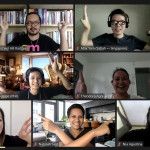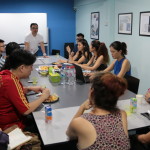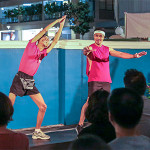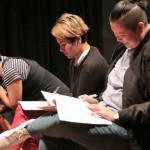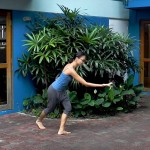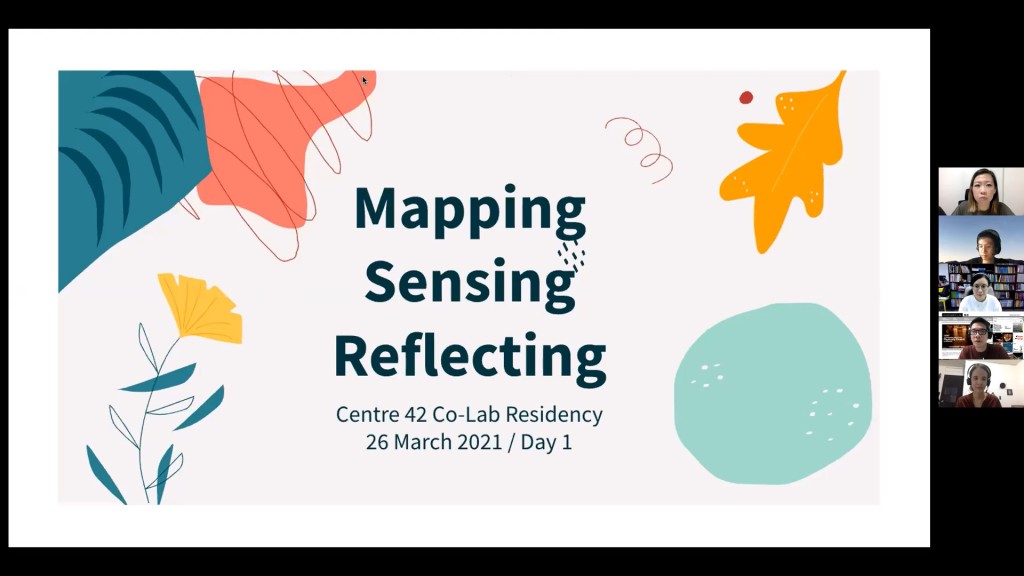
Screenshot of “Mapping Sensing Reflecting” on Day 1 of Critical Ecologies’ Co-Lab Residency
As part of a mapping exercise in April 2021, the Critical Ecologies working group listed out the various critics, writers and/or practitioners who mentored them and influenced their growth, as well as those whose work they had read extensively and were inspired by. This piece is a condensed and edited version of the exercise, which sought to explore and reflect on the personal lineages and histories of the working group’s varied practices of criticism.
Click on the arrows to read more about each member’s inspirations
Centre 42 (a theatre development space that documents and promotes writings for the Singapore stage)
C42 gave me a baseline idea of what a review could look like. It was the first official program that allowed me access to a substantial pool of local theatre works and where to even start reviewing.
小西 (Xiao Xi – a veteran reviewer from Hong Kong)
Xiao Xi outlines an accessible structure of what is important in a review. He reminds that theatre is experiential, and empathising with our body as an onlooker of the work is important, especially if the reviewer also gets to attend rehearsals of the work. This point also resonates with the practice of Arts Republic, in a bid to have a better feel of a work, we often drop by rehearsals to see a work’s evolution. He also emphasises on ‘space’ as part of the structure of a play, rather than just the vessel, set or venue.
Liu Xiaoyi (theatremaker in Singapore, now based in Hong Kong)
Xiaoyi outlines an inquiry structure that helps me think about the act of reviewing, which is also the act of gazing. While other more formal modules on critique focus more on the writing, Xiaoyi’s mentoring focuses on how the reviewer can ‘behave’ during the ‘on-looking’ process. He highlights that form is/as content, the role of subject vs object in viewing a work, what is the implied reader, and how we can explore narrative ⋂ context when viewing and reviewing a work.
Both Xiao Xi and Xiaoyi talk about gaze (注视 zhu shi), scrutinising (盯着 ding zhe), act of watching (观看 guan kan).
Patrick Flores’ practice spans curation, education, and art scholarship, but when I first encountered his work in an exhibition catalogue, he simply struck me as an imaginative and playful writer. In 2019, when I worked with him briefly for a writing project, he encouraged me to explore a more speculative register. Whereas history has a tendency to fix definitions and readings or to place things within rigid categories, he reminds that a writer’s task is not to fix and declare but to let meanings dilate. A similar openness guides his ideas on art criticism. Criticism isn’t simply negating, giving judgment or a final verdict. These inspire me to speculate on criticism’s other possible routes. Or criticism as an open form.
Eileen Legaspi-Ramirez is a scholar, art critic, educator, and curator, and I’ve been inspired by the very fierce and generous ways in which she moves across these practices. Eileen writes with so much verve and muscle. She asserts her position with a strong authorial voice. As a mentor, she has constantly encouraged me to wrestle with questions of ethicality—ethical not just on the side of the artist and the critic, but also ethical for the audiences, publics, and communities affected by the work. The public has voice and agency—how do we explore this in criticism? Her practice also makes me consider that, in writing, the critic’s voice is not the only voice that needs to come to the fore.
Alice Guillermo’s work as an art critic and activist made me situate art within wider social ecologies. Until now, I’m still floored by how she chose to write widely, both in academic contexts and in mainstream media. Early in my practice as a media writer, when I read chapters of her book on social realism, it gave me a lasting impression that part of a critic’s responsibility is to enable new ways of seeing, interpreting, supporting, and evaluating art practices that are obscured by market systems. There was also so much sensitivity, rigor and patience in the way that she would describe the sensuousness of a work. I think it’s partly because she was still a teacher when she wrote. She seemed to be challenging the reader to learn with her.
Krishen Jit: His writing is very important to not just me but to other critics and theatre makers as well. His writing is very sharp and thought provoking with very good details in analysing drama and theatre from a perspective of a historian, director and dramaturg. His writing also shows that he is very supportive yet critical to further nurture Malaysian theatre during its development.
Salleh Ben Joned: He wrote in different kinds of genre (essay, poem, article and review) but with consistent style and tone of writing. I can sense the anger, wit, sarcasm and assertiveness in his writing. He never compromised his principles.
Kathy Rowland: I am very inspired by her writing but mostly on how she moderates verbal communication during panel discussion. I realise that to be a good critic you must be able to ask a very good question which is another different set of skills in criticism.
Sal Murgiyanto, I remember the first time I read his book, “Kritik Seni Pertunjukan dan Pengalaman Keindahan” (Performing Arts Criticism and the Experience of Beauty), I just admired how Sal wrote all those articles. It seemed fair, critical and sharp, but I could still get the intimate and emotional feelings of the work. I felt that Sal is close with all the people behind the productions/events (I don’t know the truth, but I felt that). He knows how to write about each one with different tensions. It’s like talking with people, sometimes we talk with different approaches with different people to get the right frequency during these conversations, right? I read that in his writings too.
Helly Minarti, I work closely with her and share thoughts about art and beyond. She is also the person who first believed in me when it came to working professionally in the arts, even though I don’t have an academic background in art. From her, I got the consciousness that working in dance is working with the body, our body and other people’s bodies. It’s not just the physical body, but also spiritual, and that is why sensitivity to the energy around us plays an important role. This sensitivity should be applied to all the work we do as curator, dramaturg, writer, etc. “When you get that, you’ll be fine!” she said. For me, this kind of talk is part of the mentoring that is going on between her and me.
Nunuk Murniati, she is not an art writer. She is a senior activist on gender equality issues based in Yogyakarta. I learned from her in a short course on feminist leadership and approaches. One thing that is embedded in my mind, and is my approach to working with artists and also writing, is to work with other people, especially female co-workers. She said that, “We have to be aware that all of them (and us) have specific backgrounds, experiences, and traumas. All of those experiences are valid, we can’t blame them for that, but those kinds of things will influence how we act, how we think, and how we absorb information. So, we have to be ready to deal with that, but also work on that as a work partner, that’s why the act of caring is really important!” So, from that time on, “care” has been one of my keywords, even though it’s exhausting and needs patience sometimes, but it’s worth it when related to the result.
Bea Ledesma was the publisher and editor at Hinge Inquirer Publications. She was a very thorough and hands-on editor who emphasized the importance of balancing clarity and simplicity (she hated “purple prose”) with intelligent, thought-provoking storytelling. One of my favorite comments of hers, which may sound a little too scathing for some, is the question “So what?” She always forced us to think more deeply about what we are writing about—that it’s not just about churning out words, but making it mean something.
Ruel De Vera is a contributing writer to the Arts and Books section of the Philippine Daily Inquirer, one of the major broadsheets in the Philippines. He was my professor at the Ateneo de Manila University, and was also the moderator of the university’s student newspaper which I was a part of. Although I initially trained as a newswriter/journalist, it was through his classes that I first became able to explore various forms of feature writing and reviewing.
Cathy Cañares Yamsuan is a news and lifestyle writer for the Philippine Daily Inquirer. I got to work with her briefly as an editorial consultant and it was during that time that she became my mentor. I think more than writing, what I really learned from her was how to relate to people—be it interviewees or my own staff. It was through our (informal) “mentorship” that I learned how best to practice care while being an editor/writer.
Clarissa Oon was my supervisor and editor at The Straits Times, and the first arts critic I encountered in Singapore’s mainstream media who regarded the arts ecology with a deep thoughtfulness, generosity and curiosity. Clare’s always been very sensitive to the relational aspects of performance-making, but is also really sharp and insightful when it comes to cultural policy, as well as observing and adapting to the maturation of both Singapore’s performance scene and media industry. She wrote a meticulously researched book on the history of Singapore’s English-language theatre while working as a journalist, which to me embodies the loving attention to context and encyclopedic knowledge of local histories that I believe critics should espouse.
ArtsEquator (and the women who run it – Kathy Rowland, Nabilah Said, Denise Dolendo), have profoundly and irrevocably altered the landscape of arts writing and criticism not just in Singapore/Malaysia but Southeast Asia. I feel like ArtsEquator is revolutionizing what writing with and about art can be, and how our region connects with each other and takes each other as reference points for learning and growth. They are so, so good at building and sustaining community not only through writing, but also through their mentorship programmes, reading groups, live panels, and their flagship programme: the Asian Arts Media Roundtable. ArtsEquator conceives of criticism as an affective practice, one grounded and embedded in both the poetics and politics of the sites we are from.
Katrina Stuart Santiago reminds me always that to be a critic is also to be an ally, advocate and activist. Her work in Manila with PAGASA (People for Accountable Governance and Sustainable Action) is so urgent and responsive when it comes to addressing and questioning policies, precarities and crises around cultural labour in the Philippines. She reminds me that criticism is an act of radical hope, a necessary antidote to self-censorship, opacity, and fear.
One of my influences is Clarissa Oon, but as Corrie has written about her and I wholeheartedly agree with what she’s said, I will spread the love around 
Kathy Rowland is my ou xiang (idol). She leads our small team at ArtsEquator with grace and ferocity. She, alongside our co-founder Jenny Daneels, recognised that we don’t see enough writing about the arts in Southeast Asia, especially arts criticism, and finds new ways of exploring this through the website, live events and our podcast. Through this, I’ve ventured outside of my comfort zone of the written word to develop my skills in those areas. In terms of criticism, Kathy taught me the value of being gentle, yet incisive and tough when necessary, backed up by good knowledge of the local artistic context.
Ruby Thiagarajan is the literary critic behind the well-written newsletter, Tote Bag Library. She writes about books, literary and pop culture in a really assured, accessible tone, and does not shy away from really sharp criticism. She peppers her writing with memes and occasionally, photos of her dog, making her writing fun and honest. She uses social media well to interest a new generation in partaking in the act of reading criticism.
From my time in London in 2017-2019, I was exposed to fearless women who are challenging the predominant hegemonies of criticism in the UK. When I wrote for Exeunt Magazine, my editor Alice Saville allowed me to write in different formats, such as poetry, and validated the act of creative criticism. (Her multi-draft, satirical review of Bitter Wheat was seminal for me). Ava Wong Davies is another young writer who is unapologetic about the subjectivity of her critical voice, and carries herself well, always radiating confidence, which is simple yet inspirational to me. And lastly, an iconoclastic duo who I love endlessly are Zarina Muhammad and Gabrielle de la Puente of The White Pube.
Joned Suryatmoko: Saya mengenal teater dari bergabung dengan kelompok beliau (Sanggar Gardanalla) pada 2000-2001 dan menjadi relawan pada beberapa produksi setelahnya. Dari Joned saya belajar tentang beberapa pandangan mengenai inovasi di dalam teater dan bagaimana memandang teater yang berbeda harus dengan kacamata (sudut pandang) yang berbeda pula.
I first got acquainted with the theatre when I joined Joned’s group (Sanggar Gardanalla) in 2000-2001 and volunteered for several productions afterwards. From Joned, I learned about the various views on innovation in theater, and how to view different forms of theatre through different lenses (viewpoints) as well.
Ramses Surobuldog: Barangkali tidak terkenal. Dia adalah seorang musisi amatir dan pernah bekerja sebagai pegiat pemberdayaan masyarakat melalui kerja-kerja media (audio dan visual). Bersama Ramses saya pernah terlibat dalam project musik penciptaan lagu-lagu untuk kampanye kesetaraan gender. Ramses mempengaruhi cara berpikir dan bersikap saya terhadap seni terutama musik.
Probably not as well-known. He is an amateur musician and has worked as a community empowerment activist through various media works (audio and visual). Together with Ramses, I was involved in a music project to create songs for a gender equality campaign. Ramses influenced the way I think and behave towards art, especially music.
AACT.org: website dari American Association of Community Theater. Website ini adalah sumber informasi teater online yang saya temukan pertama pada sekitar tahun 2003-2004. Di dalamnya memuat direktori komunitas dan events anggota, naskah (play), dan sumber-sumber informasi baik berupa esai, practical guide dan review. Website ini yang menginspirasi saya membuat blog Jogja Teater Space (2007) dan kemudian bertransformasi menjadi gelaran.id yang fokus pada publikasi review dan esai seni pertunjukan (2017).
This is the website of the American Association of Community Theatre. This website is an online theatre information resource that I found for the first time around 2003-2004. It contains a directory of community and member events, scripts (of plays), and sources of information in the form of essays, practical guides and reviews. This website inspired me to create the Jogja Teater Space blog (2007) and later transformed into Gelaran.id, which focuses on publishing reviews and essays on the performing arts (2017).
PAR magazine: This long-running, beautifully designed magazine from Taiwan, available for borrowing at library@esplanade, was my first encounter with arts media and performing arts writing and criticism. It opened my eyes to the scenes in East Asia, Europe and America, particularly relating to programming at major venues and festivals.
Liu Xiaoyi: He writes, acts, directs and curates. As the founder of the first reviewer collective that I joined, and my first mentor in reviewing, he taught me that review is not necessarily an evaluation or judgement. Review can be ‘re-view’ — view again. He also made me aware of ‘boundaries’, and boundaries in and of theatre and performing arts can and should be questioned or challenged.
Ke Weiliang: He demonstrates the possibilities of what an independent arts media can achieve. All of the tools and formats that he uses are unconventional to the practice of mainstream arts media and criticism. As a one-man show, he is responsive to the latest trends and issues. He does not ‘produce art’ regularly, but is considered an active member of the arts community. He engages with the community extensively through various forms of ‘conversation’.
I Wayan Dibia adalah guru pertama saya yang mengajarkan cara menulis kritik. Dengan sabar beliau membaca dan memperbaiki kata demi kata, paragraf demi paragraf dari dua tulisan awal saya sebagai seorang kritikus. Ia mengarahkan saya dan memberi bingkai kritik di mata saya.
I Wayan Dibia was my first teacher, who taught me how to write criticism. He patiently read and corrected my first two pieces of writing as a critic: word by word, paragraph by paragraph. He directed me and framed criticism in my eyes.
Sal Murgiyanto menjadi penting untuk saya karena memaksa saya berpikir ulang atas apa itu seni, bagaimana menulis kritik, dan perlunya mengetahui soal tekstual karya, tidak melulu kontekstual. Saya masih ingat betul ketika Ia meminta saya untuk belajar menari agar saya juga memiliki pengalaman dan pengetahuan ketubuhan. Dari situ saya belajar menautkan tekstual dan kontekstual pada tulisan-tulisan saya.
Sal Murgiyanto became important to me because he forced me to rethink what art is, how to write criticism, and the need to know about textual works, not only contextual ones. I still remember very well when he asked me to learn to dance so that I would also have experience and knowledge of the body. From there, I learned to link both the textual and contextual in my writings.
Ardus M. Sawega salah satu jurnalis kompas dengan cara tulis yang tegas. Ia mengajarkan saya cara kerja jurnalis dengan sangat disiplin. Pertama saya belajar dengannya, saya menulis enam ulasan berbeda hanya untuk satu karya dalam waktu kurang dari 24 jam.
Ardus M. Sawega is one of Kompas’ journalists, with a very firm writing style. He taught me how to work as a journalist with great discipline. The first time I studied with him, I wrote six different reviews for just one work in less than 24 hours.
By Critical Ecologies | Critical Anomalies
September 2021
Share this post: on Twitter on Facebook on Google+

